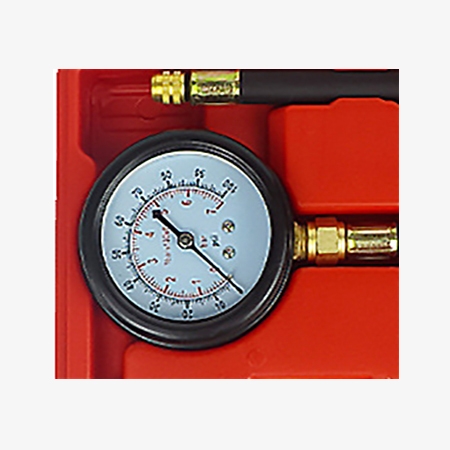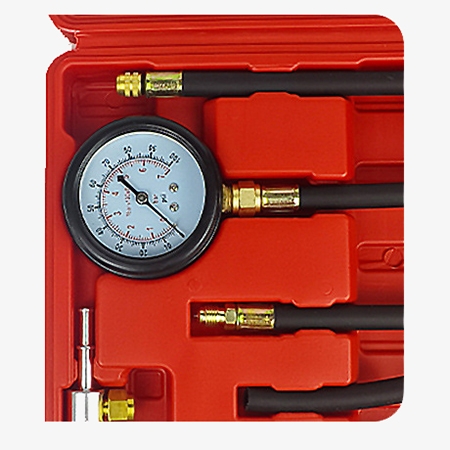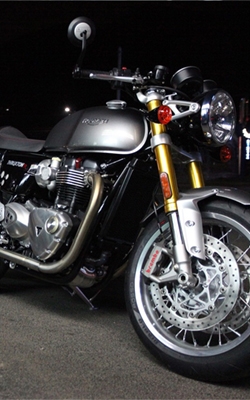The 0-100 psi fuel pressure gauge set is an essential diagnostic tool designed to measure fuel pressure in automotive, motorcycle, and small engine systems. The set includes all necessary components for easy installation, including a flexible hose, adapters, and fittings, ensuring compatibility with most vehicles and machinery.

Sophisticated Dial Design
- Fine and Detailed Scale: The fuel pressure gauge is designed with a finely graduated dial, allowing users to read even subtle changes in fuel pressure with ease and confidence.
- Accurate Pressure Display: This fuel preesure tester provides a precise indication of the fuel pressure values, ensuring that measurements are both reliable and easy to interpret during vehicle diagnostics.
- Low-Range Precision: With a minimum scale that extends to very low pressure levels, the gauge can capture slight variations that are critical for troubleshooting fuel system issues.
- Essential Diagnostic Tool: By clearly showing the fuel system’s pressure status, it helps mechanics and technicians accurately assess the condition of the fuel pump, regulator, and injectors, leading to more efficient maintenance and repairs.

Orderly Storage and Easy Management
- Custom-Molded Toolbox Design: The fuel pressure gauge set comes in a specially designed toolbox with custom-molded grooves, ensuring that each component has its own dedicated compartment.
- Secure and Fixed Placement for Each Tool: Every adapter, connector, and the gauge itself is held firmly in place within the toolbox. This secure positioning prevents the tools from moving or rattling during transport, reducing the risk of damage and making the set reliable for both workshop use and mobile diagnostics.
- Loss Prevention and Easy Organization: The structured layout eliminates the risk of misplacing smaller parts, such as fittings and adapters. With clearly defined slots for each tool, users can quickly identify missing components, saving time during setup and ensuring complete readiness for each diagnostic task.
- Neat and Professional Work Environment: By keeping all components organized in one compact case, the toolbox helps maintain a clean and professional workspace.
Application
SISCO fuel pressure gauges are used to monitor and diagnose the fuel system in vehicles and machinery, ensuring the fuel pump and regulator deliver the correct pressure. It is commonly applied in cars, motorcycles, sports car, trucks, off-road vehicles, and agricultural equipment to maintain engine performance, improve efficiency, and quickly identify fuel system problems.

Sports Car

Agricultural Vehicle

Motorcycle

Off-road Vehicle
| Model | SISCO-FPG-TU113 |
| Measuring Range | 0-100 psi |
| Accuracy | ±2 psi |
| Size | 325*260*60mm |
| Weight | 1kg |
Q1: What is a fuel pressure gauge?
A1: A fuel pressure gauge is a diagnostic and monitoring instrument designed to measure the pressure within a vehicle’s fuel system, ensuring that the fuel pump and regulator are supplying the engine with the correct amount of fuel for efficient operation. By providing accurate pressure readings, it helps mechanics and vehicle owners quickly identify issues such as weak fuel pumps, clogged filters, leaking lines, or malfunctioning regulators that could cause hard starting, poor performance, or even engine damage. Fuel pressure gauges come in both mechanical and electronic types, with mechanical gauges typically used for quick under-hood checks and electronic gauges often paired with sending units for real-time, in-cabin monitoring. They are widely used across different applications, from carbureted engines that require low-pressure readings to modern EFI systems and high-performance or diesel engines that demand higher pressure ranges, making them an essential tool for both troubleshooting and ongoing performance management.
Q2: Why do I need a fuel pressure gauge?
A2: You need a fuel pressure gauge because it plays a crucial role in ensuring that your vehicle's fuel system is operating at the correct pressure, which is vital for proper engine performance, fuel efficiency, and long-term reliability. Without the right fuel pressure, your engine may experience hard starting, rough idling, hesitation during acceleration, misfires, excessive fuel consumption, or even stalling, all of which can lead to costly repairs if not addressed promptly. A fuel pressure gauge allows you to quickly and accurately diagnose whether problems are caused by a weak or failing fuel pump, a clogged fuel filter, a leaking fuel line, or a faulty pressure regulator, saving time during troubleshooting and helping prevent unnecessary part replacements. For performance enthusiasts and diesel or high-horsepower applications, a fuel pressure gauge is also an important monitoring tool, giving you real-time feedback to ensure the engine is always supplied with adequate fuel under varying loads and driving conditions.
Q3: Where do I put fuel pressure gauge?
A3: A fuel pressure gauge can be installed in different locations depending on whether it is used for temporary testing or permanent monitoring. For diagnostic purposes, it is commonly connected to the Schrader valve on the fuel rail, spliced inline with the fuel line, or attached to the test port on the fuel pressure regulator. For long-term use, the gauge may be mounted under the hood for quick visual checks, or paired with an electronic sending unit that transmits readings to a gauge inside the cabin, allowing the driver to monitor fuel pressure in real time. This electronic setup is preferred for safety, since it avoids the hazard of running a raw fuel line into the passenger compartment.
Tips: Is the fuel injection pressure tester kit easy to use?
Yes, the fuel injection pressure tester kit is designed to be user-friendly and easy to use, even for those with basic automotive knowledge. The kit comes with clear instructions and all the necessary components, such as adapters, hoses, and fittings, that allow for quick and straightforward connections to the vehicle’s fuel system.
Here’s a simple overview of how to use it:
- Connect the tester to the fuel rail or test port on the engine using the provided fittings and hoses.
- Start the engine and turn the ignition on (follow all safety precautions).
- Read the pressure on the gauge, which will display the fuel pressure in PSI.
- Compare the reading to the manufacturer's recommended fuel pressure range to diagnose potential issues with the fuel system.
Thank you for buying industrial test and measurement equipment on SISCO.com, all products sold by SISCO and the partner cover a 12 months warranty, effective from the date of receiving the products.
What is covered?
SISCO is responsible for providing free spare parts, and free technical support to assist the customer to repair the defective products until the problem is solved.
What is not covered?
- Product purchased from anyone other than a SISCO store or a SISCO authorized reseller.
- Expendable parts.
- Routine cleaning or normal cosmetic and mechanical wear.
- Damage from misuse, abuse or neglect.
- Damage from use of parts other than SISCO approved.
- Damage from use outside the product’s usage or storage parameters.
- Damage from use of parts not sold by SISCO.
- Damage from modification or incorporation into other products.
- Damage from repair or replacement of warranted parts by a service provider other than a SISCO authorized service provider.
- Damage caused by the application environment not meeting the product usage requirements and the failure to perform preventive maintenance.

